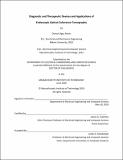Diagnostic and therapeutic devices and applications of endoscopic optical coherence tomography
Author(s)
Ahsen, Osman Oguz
DownloadFull printable version (12.05Mb)
Other Contributors
Massachusetts Institute of Technology. Department of Electrical Engineering and Computer Science.
Advisor
James G. Fujimoto.
Terms of use
Metadata
Show full item recordAbstract
There is an increased demand for developing transformative technologies to satisfy unmet needs in the clinical management of a number of gastrointestinal (GI) tract diseases. With the maturation of sweptsource lasers, OCT technology has undergone major advancements over the last few years. Swept-source laser sources based on Fourier domain mode locking (FDML), akinetic and vertical cavity surface emitting laser (VCSEL) technologies have shown to reach and exceed MHz OCT imaging speeds. Our group has harnessed these advances by developing an ultrahigh-speed endoscopic OCT system that operated at and above 600 kHz A-scan rates, > 10 times faster than commercial endoscopic OCT systems. Equipped with distal rotating micromotor catheters, this system allowed visualization of microstructures and functional processes that were not possible to observe with the older generation OCT systems. The overarching aim of this thesis was to showcase novel clinical and research applications that were enabled by this next generation ultrahigh-speed endoscopic OCT system. Towards this aim, this thesis focused on two main projects, 1) Demonstrating clinical applications of volumetric en face and crosssectional OCT, and OCT angiography (OCTA) and 2) Developing integrated OCT imaging and esophageal electrical muscle stimulation methods. For the first project, two gastrointestinal (GI) tact diseases were investigated: Barrett's esophagus (BE) and associated dysplasia, and chronic radiation proctopathy (CRP). For the second project, esophageal electrical muscle stimulation methods were assessed to achieve circumferential esophageal tissue coverage for catheter imaging and therapeutic applications, with experiments performed in living swine. Furthermore, methods for improving scanning stability and robustness of the ultrahigh-speed endoscopic OCT system, as well as for optimizing data acquisition and visualization were discussed. This thesis illustrated that ultrahigh-speed endoscopic OCT technology powered by the next generation swept-source light sources and precision scanning micromotor catheters opened new research directions ranging from diagnosis of early cancers to studying the pathophysiology of GI tract diseases and assessing efficacy of and response to therapeutic interventions. As the field of OCT continues to evolve, endoscopic OCT is one step closer to find its niche in solving prolonged clinical problems.
Description
Thesis: Ph. D., Massachusetts Institute of Technology, Department of Electrical Engineering and Computer Science, 2018. This electronic version was submitted by the student author. The certified thesis is available in the Institute Archives and Special Collections. Cataloged from student-submitted PDF version of thesis. Includes bibliographical references (pages 154-171).
Date issued
2018Department
Massachusetts Institute of Technology. Department of Electrical Engineering and Computer SciencePublisher
Massachusetts Institute of Technology
Keywords
Electrical Engineering and Computer Science.